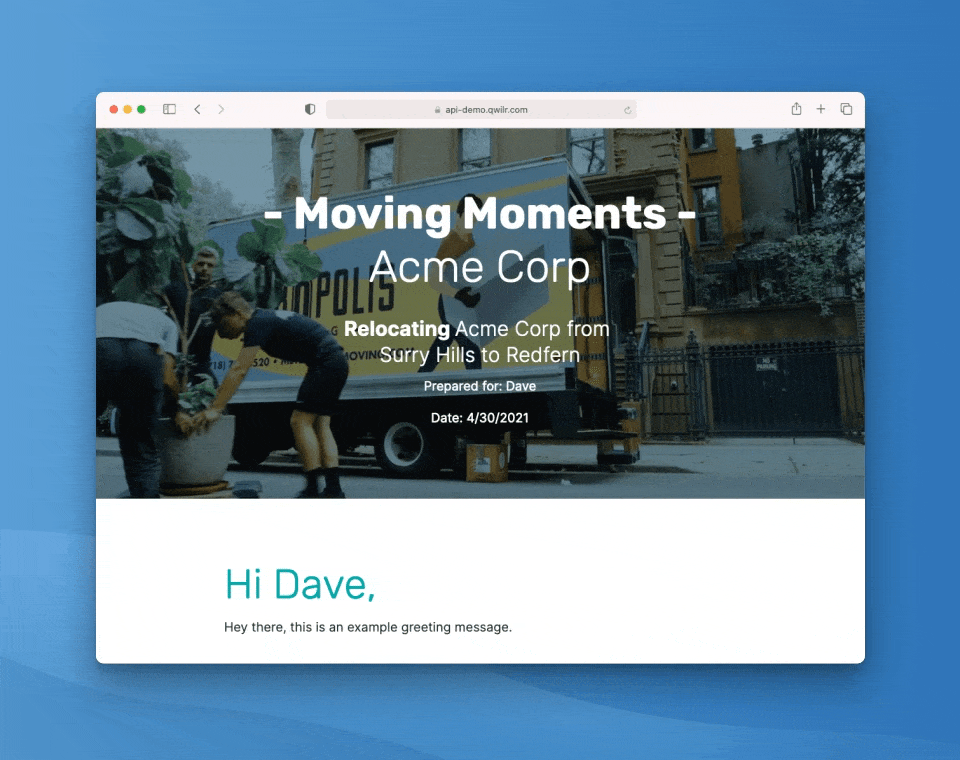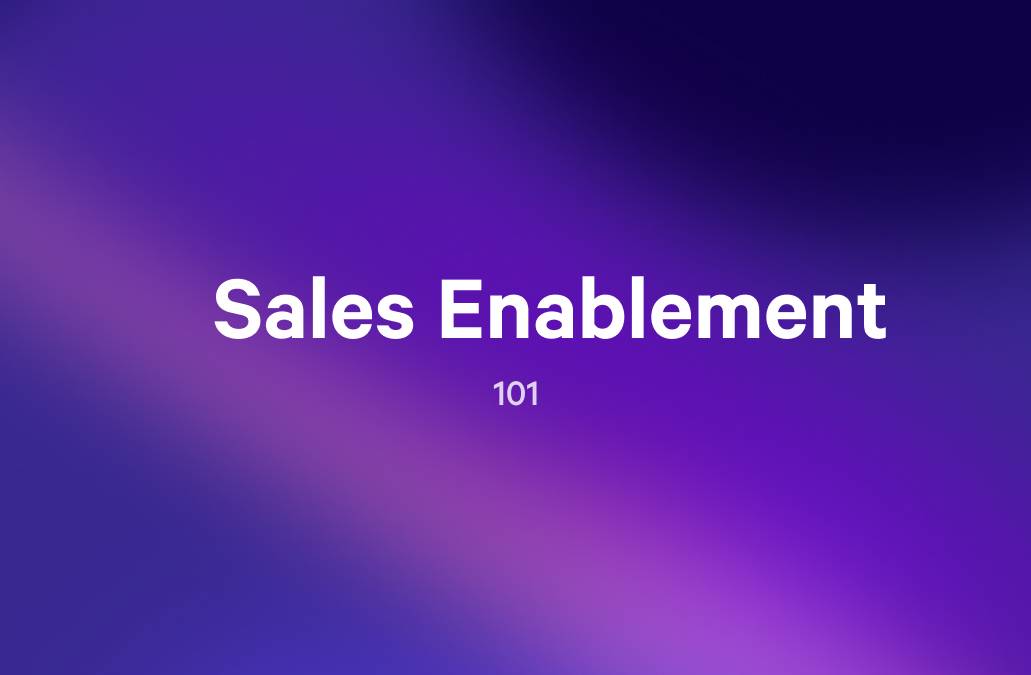One of the easiest ways to increase the efficiency of your sales team is to have plenty of ready-to-go sales enablement content. Rather than spending time producing collateral for prospects individually, a well-oiled sales enablement machine ensures that sales teams are equipped to meet their prospect's needs -- allowing them to focus on higher-value activities.
Not sure what content your sales teams need or where you should start? Read on for our top tips and insights.
Key Takeaways
- Sales enablement content is designed to support sales reps across the sales cycle.
- It can be used internally by the sales rep or externally with a prospect or client.
- Having a sales enablement content strategy can help organizations shorten their sales cycle.
- To create sales enablement content, you may need to spend time understanding what sellers need, why your sales team is winning or losing deals, and what customers need to hear to say yes to your product or service.
- Examples of sales enablement content can include proposals, blog posts, eBooks, email and phone scripts.
What is sales enablement content?
Sales enablement content is a type of sales content that is designed to help sellers engage with prospects over the course of the sales cycle. It's intentionally designed to provide sales reps with the data and resources they need to effectively communicate the value of a product or service and close deals.
This content may be designed to help sellers in specific conversations or to provide additional information directly to a prospective customer.
What is a sales enablement content strategy?
A sales enablement content strategy is the comprehensive plan that outlines how an organization will create, manage, and distribute content to support its sales team.
The strategy might take into consideration the needs of the sales team, the resources available to create the content, and how to ensure content is appropriately prioritized and aligned with the company's goals and targets.
Internal vs. external enablement content
Internal sales enablement content is designed to support sales reps. It is not meant to be shared with a client or prospect. Examples of internal sales enablement content might include scripts for phone calls or emails, battle cards and competitor analysis.
External sales enablement content is created to be shared. Its primary focus is on educating and engaging potential customers. Examples of external sales enablement content include proposals, blog posts or articles, eBooks, and case studies.
Why is sales enablement content important to a business?
Sales enablement content is important to a business because it can speed up sales cycles, bringing in more revenue in a shorter period of time.
By equipping salespeople with content to help them along the sales process, you make it easier to get deals done.
For example, if your company has prepared battlecards with key information about all of your direct and indirect competitors and key statistics to help sales reps overcome objections, you might save the rep hours of research or searching for ways to answer prospects' questions or overcome their objections.
When it comes to prioritizing sales enablement content in the business, Tania Clarke, Qwilr's head of Product Marketing, says:
"Consistency in message = consistency in success. If all the sellers are pitching your product in lots of different ways, it's setting prospects up for disappointment and confusion if the expectations they were sold on doesn't match the actual product they purchased. Sales enablement allows consistency of message, and success to be scalable."
How to create sales enablement content
Creating sales content in your own organization doesn't have to be overwhelming. Use these sales enablement tips to get started,, and you'll soon have a small library of sales enablement content to share and grow.
Involve your sellers and other key stakeholders
In order to get a consistent message that accurately conveys the product your customers are going to get, you need to involve not only your salesforce but also key stakeholders in marketing, customer success or operations in the planning and execution of your sales enablement content.
This process might start with a group brainstorm or whiteboarding session to map out sales enablement needs and key messages.
Colin Hugo, Head of Tech Sales, says:
"Involve the people that live and breathe sales within your business, from junior to senior employees.sales enablement content is created without input from those who have daily touchpoints with clients. This results in content that doesn't resonate with the sales team, which ultimately sets the whole process up for failure. You need to have instant buy-in, if the content sounds like fluff it will fall on deaf ears."
Prioritize based on sales reps needs
Unless you have a very large sales enablement team, you won't be able to create every piece of sales enablement content you will eventually need. This is why you want to start with the most important pieces of content and grow your content library over time.
Which piece of content is most important? The answer to this may vary greatly from organization to organization so you'll want your sales reps to help you make an informed decision here.
Ensure you're addressing customer's needs
Part of addressing your salesforce's needs is ensuring your customer's needs are met. Equipping your sellers to share information and answer customer's questions in a timely manner is critical to the success of your sales enablement program.
Be concise
When creating sales enablement content, sometimes less is more. Erman Ergun, Head of Sales Enablement at Jotform says, "Sales reps are busy folks; they need info they can grab on the go. Focus on what's really going to help them—think quick reads that tackle customer pain points and highlight the benefits. Use visuals and bullet points to make it engaging and easy to skim. It's all about making their lives easier, so they can close deals faster."
Ask for feedback and iterate
Creating sales enablement content is never a set it and forget it activity. This content has.a job to do and that is working for your sales team. So, you need to get regular feedback about how it's working. What are sellers using during sales conversations, presentations, proposals and follow ups? Is that the most effective resource you can provide?
Tania Clarke reminds sales enablement pros to regularly check in with their reps on whether the content produced is helpful. She says: "This doesn't involve nagging them constantly, but making sure there is a ritual or meeting in place where they can openly share feedback, or if there's a budget: put a tool in place that can track this automatically."
Types of sales enablement content
With so many types of content in play, it can be overwhelming to produce all of it. This is where good sales enablement strategies come into play. Choosing the right content for your organization will take a little research and planning.
But, once you've decided what to produce you can use our top tips for each piece of content to give you a head start.
1. Proposals
As a type of sales enablement content, proposals help sales teams communicate their value proposition clearly, showcasing how their product or service addresses specific pain points. Well-crafted proposals not only present detailed information on deliverables and costs but also include personalized insights, timelines, and next steps, helping prospects make informed decisions.
Interactive proposals, like those offered by Qwilr, take this a step further by incorporating tracking, e-signatures, and payment options, making the sales process more efficient and client-friendly.

Our top tip for proposals: Using proposal management software to create and share proposal templates with your sales team will save time and effort. Sales reps won't need to start from scratch every time they want to write a proposal and the final documents will be aligned with brand guidelines.
Tania Clarke gives us insights into how she uses Qwilr for sales enablement,
“Our sellers prefer to have 'blocks' they can drag and drop in to design a bespoke proposal for every customer. This is easily and quickly created in Qwilr, and doesn't need to go through design loops that can drag out timelines.”
2. Buyer Personas
Buyer personas are detailed representations of a company's ideal customers, based on market research and real data about existing clients. These profiles typically include demographic information, job roles, challenges, goals, and buying preferences, allowing sales teams to tailor their messaging and approach for more effective engagement
Our top tip for buyer personas: Create buyer personas and update them regularly. Humanizing your buyer profiles can help sellers think through their sales pitch and provide more relevant content for prospects along the customer journey.
3. Buyer Journey Maps
These are great visual representations that clearly outline all the steps that a potential customer may take from the problem awareness stage through to purchasing decision. Outlining each buyer stage—awareness, consideration, and decision—helps sales teams understand the information and support that prospects require at each stage.
Our top tip for buyer journey maps: In conjunction with providing buyer personas, sharing buyer journey maps with your sales professionals can help them have a better understanding of how purchasing decisions get made. This can lead to a smoother sales process overall.
4. Blog posts or informational articles
While blog posts may be the marketing department's thing, they can also be a secret weapon for sellers. Having blog posts or informational articles available to sellers can help take routine follow-ups from a painful experience in nagging to becoming a helpful resource for prospects.
Our top tip for blog posts or informational articles: Create and share blog posts that address common industry challenges and provide actionable information to solve customer problems. Focus on blogs that showcase how your solutions fit into the broader conversation.
5. Case Studies
Case studies are powerful tools for building credibility and showing practical, real-word applications of your solution. These detailed success stories speak to the bottom line, demonstrating how you’ve solved problems for customers or aided them in reaching their business goals. Case studies are especially good here since they contain an element of social proof.
Our top tip for case studies: Regularly updating your case study library gives sellers additional customer-facing content to use as they're selling. When creating case studies, Look for cases that highlight common challenges your target audience faces and quantify the results with specific data and hard numbers.
6. eBooks
For maximum detail, choose longer-form educational content that goes into detail on specific topics relevant to your industry or customer pain points. E-books are typically used to generate leads by offering a download in exchange for contact information.
Our top tip for eBooks: When it comes to creating eBooks and longer form content to support sales, make sure your topics are relevant, timely and actionable. Being known for great content can help build trust with an audience, something they remember when they're ready to buy.
7. White Papers
Create in-depth, research-based documents that provide detailed information on a specific topic related to your industry or solution. Whitepapers position your company as a thought leader and help to educate prospects on complex issues.
Our top tip for white papers: If you're using whitepapers as part of your external content strategy, consider where you might be able to bring in more visuals to keep things fresh. Illustrations, infographics, and even data visualizations can help bring concepts to life.
8. Explainers (pre-recorded videos)
Short and engaging videos that showcase how your product or service works help to simplify complex concepts. Visual sales enablement content helps to create a strong impression and impact.
Our top tip for explainers: Keep your explainer video content fresh. Partner with your customer success team or even customers to show real use cases that resonate with prospects.
9. Webinars
Live or recorded online presentations that educate prospects about industry trends, challenges, and how your solution can address them. Webinars provide an interactive way to engage prospects and demonstrate your expertise.
Our top tip for webinars: One of the more challenging content pieces to bring together, aim to have a cadence for your webinars. Alternate between talking about industry challenges, success stories and other topics that are most relevant to your customers to encourage regular participation.
See how we put together a sales enablement webinar to discuss industry challenges on an expert panel:
10. Phone Scripts
These pre-written guides help sales reps navigate conversations with prospects over the phone and ensure consistent messaging and a guideline for objection handling.
Our top tip for phone scripts: Writing phone scripts can feel forced and awkward. Start by listening to a few good sales calls and write out the salient points. Build your phone script around this messaging. Phone scripts should include key points, questions to ask and responses to common objections.
11. Email Templates
Pre-written email messages should be designed for different stages of the sales funnel to provide sales reps with consistent messaging for cold outreach, follow-ups, or nurturing campaigns.
Our top tip for email templates: Have some key performance indicators around email opens and clicks. Continue to optimize your templates based on your best-performing emails.
You may also want to make your proactive emails more of a two-way conversation and encourage prospects to reply and engage instead of simply unsubscribing.
12. Product Overviews (one-pagers)
One-pagers provide a concise, single-page document that gives an overview of a product or service, highlighting key features, benefits, and use cases. These are often used during prospecting to quickly communicate the value proposition.
Our top tip for product overviews: These are called one-pagers for a reason. Brevity matters. Putting all of the key features and their potential impact on one page can help sellers when they need it most.
When designed well sales teams can get more bang for their buck, as these one page overviews also make great leave behinds or follow-ups to share with clients and prospects.
13. Price Lists
As a type of sales enablement content, price lists provide sales teams with a clear and standardized reference to share with prospects, ensuring transparency and consistency in pricing conversations. These lists help sales reps quickly respond to pricing inquiries and assist prospects in evaluating different options based on their budget or needs
Our top tip for price lists: Having a list of prices or pricing ranges in one central location is a huge time saver. Listing prices by product, service or SKU so that sellers can easily create estimates for sales presentations or proposals can save a lot of time which can be used for personalization and extra effort to really wow a prospect.
14. Competitor Battlecards
Sales enablement battlecards are quick-reference guides that equip sales teams with essential information about competitors, including strengths, weaknesses, and key differentiators. These cards help sales reps respond to competitive objections during conversations.
Our top tip for competitor battle cards: In addition to some basic research ask your sellers what they are hearing about competitors. While gossiping about other sales teams won't move the needle—real competitive intelligence about what competitors do well and where they can improve will help sellers rise above the competition.
15. Objection Handling Battlecards
Coming up with a rebuttal for a prospect's objection on the fly can be challenging. By rounding up some of the most common sales objections and having a few rebuttals on hand can help sellers save face in the moment and keep the conversation going.
Our top tip for objection handling battlecards: Ensure that each objection is met with an empathetic response that acknowledges the prospect's concerns, followed by a value-driven counter. Offer solutions rather than just rebuttals.
16. Product Demo Agendas
Having a templated agenda for a product demo can be just as helpful as a proposal template or pitch deck. It gives the seller a good starting point instead of forcing them to start from scratch. They will remember to hit all of the key points but also have room to tailor the agenda to their prospect's needs.
Our top tip for product demo agendas: Gather key information about the prospect’s specific challenges and goals and customize the demo to focus on the features and solutions that address their unique pain points to make the demo more relevant and impactful.
17 Customer reference lists
Putting together a vetted list of customers who can act as a reference is yet another huge time saver. Having the references tagged in your content management system or CRM by type of customer, length or partnership or other relevant details means that sellers always have a relevant reference at their fingertips. No more waiting around for a customer to call them back and agree to serve as a reference. Saving hours or days in the sales process.
Our top tip for customer reference lists: Organize the reference list by industry, company size, or use case so sales reps can easily match relevant references to their prospects. This makes it more effective when prospects want to hear from similar companies.
18. Testimonials
Social proof, such as testimonials and user endorsements, lend your brand credibility. It’s also a great way to build trust with your customers and prospects by showing them how others have benefited from your product or service.
Our top tip for testimonials: Build a robust library of testimonials that your sales reps can dig into when needed. Add relevant testimonials can be added to proposals, presentations and other sales communications.
19. Win/Loss Analysis
Creating and sharing regular win/loss analysis reports can help the entire sales team. Seeing in customer's own words what they experienced and why they said yes or no can be one of the most effective strategies for improving.
Our top tip for win/loss analysis: Collect input not just from the sales team but also from customers, prospects, marketing, and product teams to get a well-rounded view of why deals were won or lost.
20. Playbooks
These comprehensive guides ensure that reps are aligned with the company’s sales methodology and have easy access to tools, resources, and talking points to improve performance. Remind team members that playbooks are not step-by-step scripts; they're resources to help guide action based on the situation. Think of a football game. If it's the fourth quarter and you're down by three, you don't make the same play as if you're up by 10.
Our top tip for playbooks: Break down the playbook into sections with clear, actionable steps. Use bullet points, templates, and visual aids like flowcharts to ensure it’s easy for sales reps to quickly find the information they need without feeling overwhelmed.
Increase productivity with effective sales enablement content
In some insights from our own Product Marketing Manager, Guy Hall, he shares how strong sales enablement content can make a huge difference in the success of a sales cycle.
He says, "High-quality content equips sales reps with the information and collateral that they need to help address objections and support their claims."
Having ready-to-go sales enablement content can also increase the efficiency of your sales team. Rather than spending time producing collateral for prospects on an individual basis, a well-oiled sales enablement machine ensures that sales teams are equipped to meet their prospect's needs -- allowing them to focus on higher-value activities.
Qwilr is a fantastic tool for sales enablement. It allows you to effortlessly create compelling collateral that cuts through the noise with its dynamic and interactive elements. The fact that you can view analytics, and assess which aspects of your content people are engaging with is invaluable when it comes to future iteration. Want to see this in action? Book a demo today.
About the author

Marissa Taffer|Founder & President of M. Taffer Consulting
Marissa Taffer is the Founder & President of M. Taffer Consulting. She brings over 15 years of sales and marketing experience across various industries to a broad range of clients.


